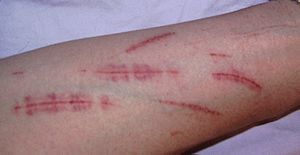Self-harm
| Self-harm | |
|---|---|
| Synonyms | deliberate self-harm (DSH), self-injury (SI), self-poisoning, nonsuicidal self-injury (NSSI) |
 |
|
| Self-inflicted cuts on the forearm | |
| Classification and external resources | |
| Specialty | Psychiatry |
| ICD-10 | X84 |
| DiseasesDB | 30605 29126 |
| Patient UK | Self-harm |
| MeSH | D016728 |
Self-harm (SH), also known as self-injury, is defined as the intentional, direct injuring of body tissue, done without suicidal intentions. These terms are used in the more recent literature in an attempt to reach a more neutral terminology. The older literature, especially that which predates the Diagnostic and Statistical Manual of Mental Disorders (DSM-5), almost exclusively refers to self-mutilation.
The most common form of self-harm is using a sharp object to cut one's skin, but self-harm also covers a wide range of behaviors including burning, scratching, banging or hitting body parts, interfering with wound healing (dermatillomania), hair-pulling (trichotillomania) and the ingestion of toxic substances or objects. Behaviours associated with substance abuse and eating disorders are usually not considered self-harm because the resulting tissue damage is ordinarily an unintentional side effect. However, the boundaries are not always clearly defined and in some cases behaviours that usually fall outside the boundaries of self-harm may indeed represent self-harm if performed with explicit intent to cause tissue damage. Although suicide is not the intention of self-harm, the relationship between self-harm and suicide is complex, as self-harming behaviour may be potentially life-threatening. There is also an increased risk of suicide in individuals who self-harm to the extent that self-harm is found in 40–60% of suicides. However, generalising self-harmers to be suicidal is, in the majority of cases, inaccurate.
The desire to self-harm is listed in the DSM-5 as a symptom of borderline personality disorder. However, patients with other mental disorders may also self-harm, including those with depression, anxiety disorders, substance abuse, eating disorders, post-traumatic stress disorder, schizophrenia, and several personality disorders. Self-harm is also apparent in high-functioning individuals who have no underlying clinical diagnosis. The motivations for self-harm vary and it may be used to fulfill a number of different functions. These functions include self-harm being used as a coping mechanism which provides temporary relief of intense feelings such as anxiety, depression, stress, emotional numbness or a sense of failure or self-loathing and other mental traits including low self-esteem or perfectionism. Self-harm is often associated with a history of trauma and abuse, including emotional and sexual abuse. There are a number of different methods that can be used to treat self-harm and which concentrate on either treating the underlying causes or on treating the behaviour itself. When self-harm is associated with depression, antidepressant drugs and therapy may be effective. Other approaches involve avoidance techniques, which focus on keeping the individual occupied with other activities, or replacing the act of self-harm with safer methods that do not lead to permanent damage.
...
Wikipedia
